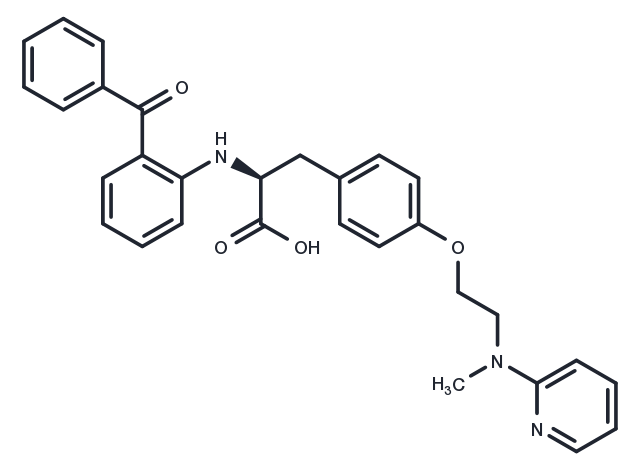Powder: -20°C for 3 years | In solvent: -80°C for 1 year
GW1929是PPAR-γ有效激动剂,对人PPAR-γ的pKi 为8.84。对人和鼠的pEC50分别为8.56 和 8.27。

| 规格 | 价格/CNY | 货期 | 数量 | |
|---|---|---|---|---|
| 1 mg | ¥ 329 | 现货 | ||
| 5 mg | ¥ 763 | 现货 | ||
| 10 mg | ¥ 1,330 | 现货 | ||
| 25 mg | ¥ 2,930 | 现货 | ||
| 50 mg | ¥ 4,330 | 现货 | ||
| 100 mg | ¥ 6,180 | 现货 | ||
| 1 mL * 10 mM (in DMSO) | ¥ 835 | 现货 | ||
| 产品描述 | GW1929 is a potent PPAR-γ agonist (pKi: 8.84 for human PPAR-γ; pEC50s of 8.56 and 8.27 for human and murine PPAR-γ). |
| 靶点活性 | PPARγ (human):8.84 (pKi) |
| 体外活性 | GW1929是一种强效的PPAR-γ激活剂,对人类和小鼠的PPAR-γ的pEC50分别为8.56和8.27,同时对人类PPAR-γ、PPAR-α和PPAR-δ的pKis分别为8.84、小于5.5和小于6.5[1]。在浓度为10μM时,GW1929能够抑制TBBPA诱导的新皮层细胞培养中caspase-3的增加和TBBPA刺激的LDH释放[2]。 |
| 体内活性 | GW1929(0.5、1、5 mg/kg,p.o.)在治疗14天后显著降低了Zucker糖尿病肥胖(ZDF)大鼠的非空腹血糖水平,并具有抗脂解作用。在ZDF大鼠中,GW1929(1、5 mg/kg,p.o.)增强了β细胞对葡萄糖刺激的胰岛素分泌能力[1]。 |
| 激酶实验 | Ligand binding to bacterially expressed ligand-binding domain (LBD) of hPPAR-γ is determined by the scintillation proximity assay (SPA). The assay measures the ability of putative ligands to displace receptor-bound [3H]BRL 49653. Assays are conducted in 96-well plates. Wells contained varying concentrations of GW1929 or troglitazone; streptavidin-modified SPA beads to which biotinylated PPAR-γ LBD is prebound; and 10 nM of the specific radioligand [3H]BRL 49653 in a volume of 100 μL. The amount of nonspecific binding, as assessed by control wells that contained 50 μM of the corresponding unlabeled ligand, is subtracted from each data point. For each compound tested, plots of ligand concentration versus counts/min of radioligand bound are constructed, and apparent Ki values are estimated from a nonlinear least-squares fit of the data, assuming simple competitive binding. The results are expressed as pKi, where pKi = -log10(KI) [1]. |
| 细胞实验 | For the experiments, the cells are plated in 96-well plates at a density of 2 × 10^5 cells per cm2 and cultured in the presence of TBBPA, in concentrations ranging from 1 nM to 100 μM TBBPA. TBBPA is dissolved in DMSO, resulting in a final vehicle concentration of 0.1 % (v/v). Control (no vehicle) and DMSO-treated wells are included in the experimental design to determine the effect of DMSO. To study whether PPAR-γ is involved in the neurotoxic effect of TBBPA, cells are co-treated with 10 μM TBBPA and 10 μM GW1929 or GW9662. After 6 or 24 h of culture, 100 μL medium is collected for the LDH analysis, and the cells are collected and frozen at ?70°C for the caspase-3 activity measurements [2]. |
| 动物实验 | Animals are housed at 72°F and 50% relative humidity with a 12-h light and dark cycle and fed Formulab Diet 5008. Age- (60-day) and glucose-matched male Zucker diabetic fatty rats are gavaged twice daily for 14 days with vehicle (0.05 M N-methylglucamine), GW1929 (0.5, 1.0, or 5.0 mg/kg), or troglitazone (as the milled extrudate, in a suspension in methylcellulose, 50, 150, and 500 mg/kg). Another group of animals receives a mixture of Humulin N and Humulin R by subcutaneous injection twice daily. On days 7 and 14 of dosing, nonfasted measurements of glucose, lactate, insulin, total cholesterol, TGs, F FAs, and hematocrit are obtained. On day 14 of dosing, samples for serum drug levels (2-h postdose) and glycosylated hemoglobin measurements are also collected. In addition, once weekly, three animals from each group are placed in metabolic chambers for 48 h for quantitation of 24-h food and water consumption. Body weights are recorded throughout the study. At the conclusion of the study, perfused pancreas experiments are performed on 12 animals (n = 4 per group) that have received either GW1929 (1 and 5 mg/kg) or vehicle, to directly evaluate the effects of treatment on basal and glucose-stimulated insulin secretion. The remaining animals are killed, and their pancreases are processed for immunocytochemistry [1]. |
| 分子量 | 495.57 |
| 分子式 | C30H29N3O4 |
| CAS No. | 196808-24-9 |
Powder: -20°C for 3 years | In solvent: -80°C for 1 year
DMSO: 33 mg/mL (66.59 mM)
| 可选溶剂 | 浓度 体积 质量 | 1 mg | 5 mg | 10 mg | 25 mg |
| DMSO | 1 mM | 2.0179 mL | 10.0894 mL | 20.1788 mL | 50.447 mL |
| 5 mM | 0.4036 mL | 2.0179 mL | 4.0358 mL | 10.0894 mL | |
| 10 mM | 0.2018 mL | 1.0089 mL | 2.0179 mL | 5.0447 mL | |
| 20 mM | 0.1009 mL | 0.5045 mL | 1.0089 mL | 2.5223 mL | |
| 50 mM | 0.0404 mL | 0.2018 mL | 0.4036 mL | 1.0089 mL |
对于不同动物的给药剂量换算,您也可以参考 更多...
请在以下方框中输入您的动物实验信息后点击计算,可以得到母液配置方法和体内配方的制备方法: 比如您的给药剂量是10 mg/kg,每只动物体重20 g,给药体积100 μL,一共给药动物10 只,您使用的配方为5% DMSO+30% PEG300+5% Tween 80+60% ddH2O。那么您的工作液浓度为2 mg/mL。
母液配置方法:2 mg 药物溶于 50 μL DMSO (母液浓度为 40 mg/mL), 如您需要配置的浓度超过该产品的溶解度,请先与我们联系。
体内配方的制备方法:取 50 μL DMSO 主液,加入 300 μL PEG300, 混匀澄清,再加 50 μL Tween 80,混匀澄清,再加 600 μL ddH2O, 混匀澄清。
您可能有的问题的答案可以在抑制剂处理说明中找到,包括如何准备库存溶液,如何存储产品,以及基于细胞的分析和动物实验需要特别注意的问题。
GW1929 196808-24-9 DNA Damage/DNA Repair Metabolism PPAR Peroxisome proliferator-activated receptors GW 1929 GW-1929 inhibit Inhibitor inhibitor
